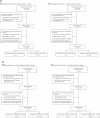Characterizing the double-sided cascade of care for adolescents living with HIV transitioning to adulthood across Southern Africa
- PMID: 32003159
- PMCID: PMC6992508
- DOI: 10.1002/jia2.25447
Characterizing the double-sided cascade of care for adolescents living with HIV transitioning to adulthood across Southern Africa
Abstract
Introduction: As adolescents and young people living with HIV (AYLH) age, they face a "transition cascade," a series of steps associated with transitions in their care as they become responsible for their own healthcare. In high-income countries, this usually includes transfer from predominantly paediatric/adolescent to adult clinics. In sub-Saharan Africa, paediatric HIV care is mostly provided in decentralized, non-specialist primary care clinics, where "transition" may not necessarily include transfer of care but entails becoming more autonomous for one's HIV care. Using different age thresholds as proxies for when "transition" to autonomy might occur, we evaluated pre- and post-transition outcomes among AYLH.
Methods: We included AYLH aged <16 years at enrolment, receiving antiretroviral therapy (ART) within International epidemiology Databases to Evaluate AIDS Southern Africa (IeDEA-SA) sites (2004 to 2017) with no history of transferring care. Using the ages of 16, 18, 20 and 22 years as proxies for "transition to autonomy," we compared the outcomes: no gap in care (≥2 clinic visits) and viral suppression (HIV-RNA <400 copies/mL) in the 12 months before and after each age threshold. Using log-binomial regression, we examined factors associated with no gap in care (retention) in the 12 months post-transition.
Results: A total of 5516 AYLH from 16 sites were included at "transition" age 16 (transition-16y), 3864 at 18 (transition-18y), 1463 at 20 (transition-20y) and 440 at 22 years (transition-22y). At transition-18y, in the 12 months pre- and post-transition, 83% versus 74% of AYLH had no gap in care (difference 9.3 (95% confidence interval (CI) 7.8 to 10.9)); while 65% versus 62% were virally suppressed (difference 2.7 (-1.0 to 6.5%)). The strongest predictor of being retained post-transition was having no gap in the preceding year, across all transition age thresholds (transition-16y: adjusted risk ratio (aRR) 1.72; 95% CI (1.60 to 1.86); transition-18y: aRR 1.76 (1.61 to 1.92); transition-20y: aRR 1.75 (1.53 to 2.01); transition-22y: aRR 1.47; (1.21 to 1.78)).
Conclusions: AYLH with gaps in care need targeted support to prevent non-retention as they take on greater responsibility for their healthcare. Interventions to increase virologic suppression rates are necessary for all AYLH ageing to adulthood.
Keywords: HIV; adolescents; cascade of care; healthcare transition; retention; viral suppression; youth.
© 2020 The Authors. Journal of the International AIDS Society published by John Wiley & Sons Ltd on behalf of the International AIDS Society.
Figures




References
-
- UNAIDS . 2018 Estimates. Geneva, Switzerland: UNAIDS; 2018. [cited 2019 Jun 15]. Available from: http://aidsinfo.unaids.org/
Publication types
MeSH terms
Substances
Grants and funding
LinkOut - more resources
Full Text Sources
Medical
Research Materials
Miscellaneous

